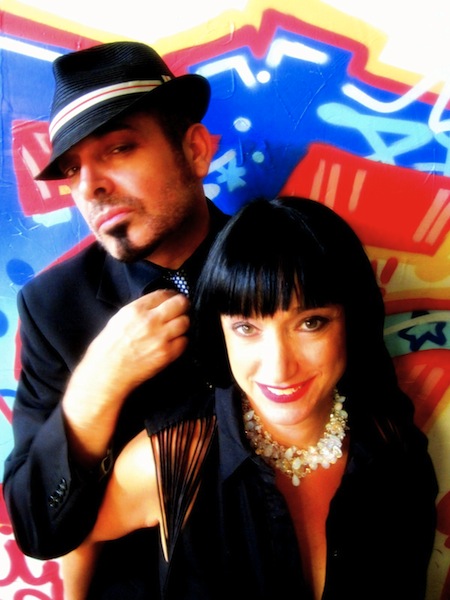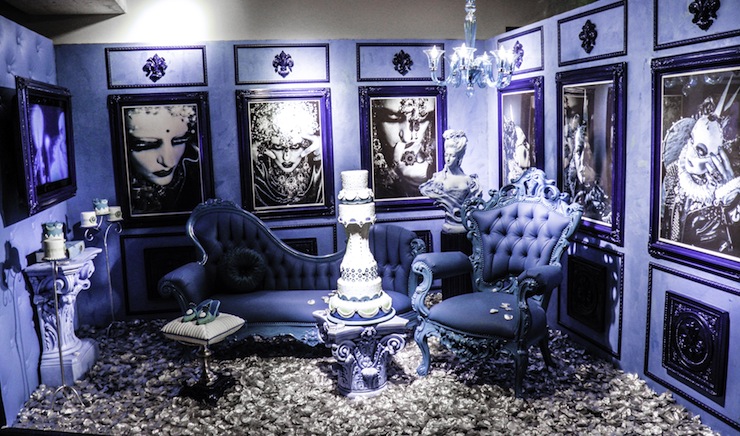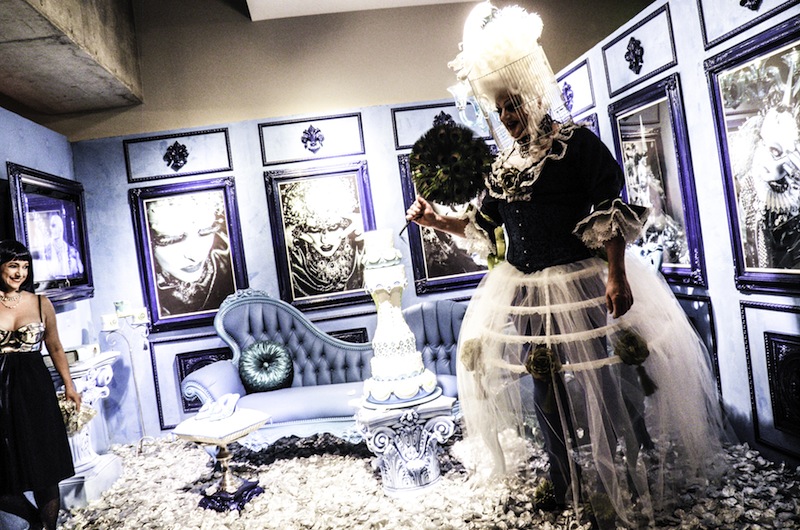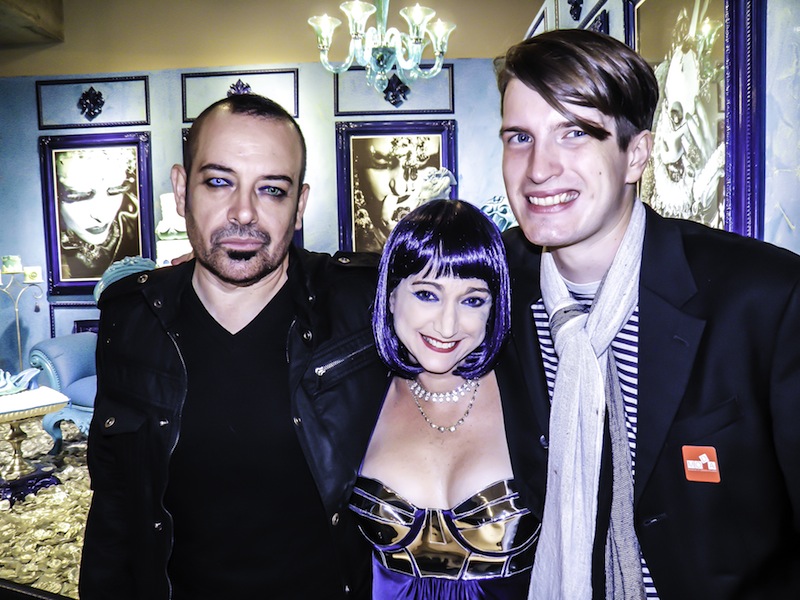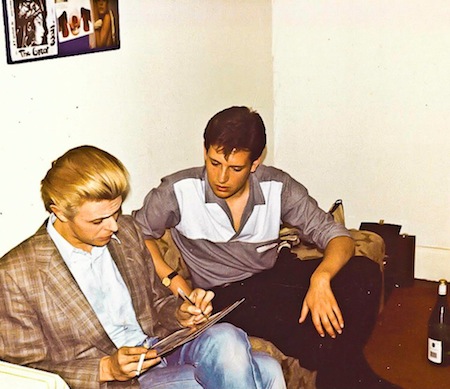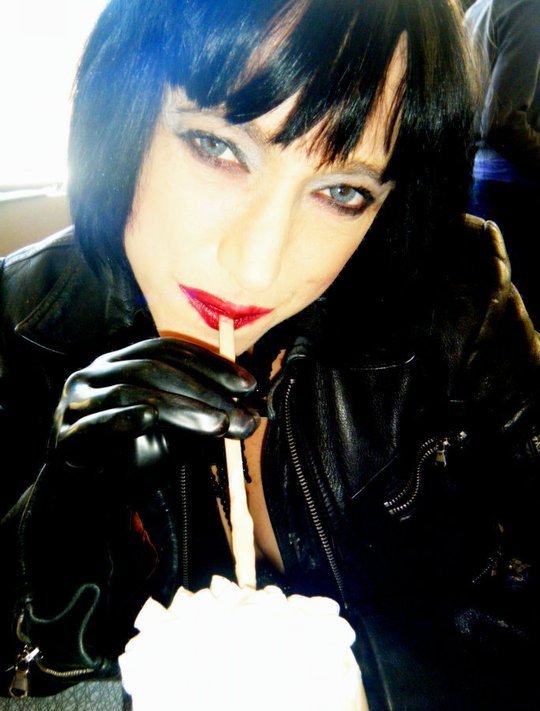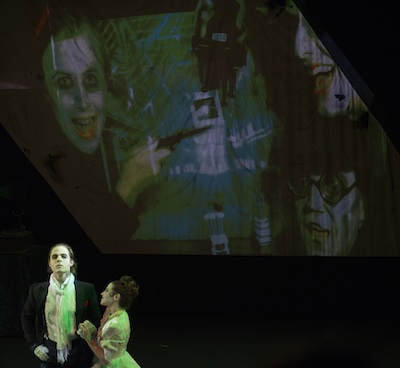
The wedding of Macheath (Aaron Strand) and Polly Peachum (Stephanie Lloyd) with cinematic insert of Mack’s trio of cohorts (Jed Drummond, Tad Cameron and Evan Hynes) Credit: Stungun Photography.
THE THREEPENNY OPERA; directed by Michael Haverty and Bryan Mercer; Play by Bertolt Brecht; Music by Kurt Weill and translated from German by Marc Blitzstein; Starring Aaron Strand, Stephanie Lloyd, Kevin Stillwell, Don Finney. 7 Stages. Sept. 9-25, 2016 (EXTENDED TO OCT. 2!). Tickets here.
Atlanta doesn’t have the theatrical reputation of many comparable American cities, but with THE THREEPENNY OPERA (Sept. 9-25), 7 Stages proves once again that this city can and does produce innovative, provocative performances of the sort one expects to see Off-Broadway. This production, envisioned and co-directed by Michael Haverty and Bryan Mercer, is quite simply a must-see if you like Brecht and Weill, value drama that provokes, disturbs, and makes you laugh like Hell, and/or don’t believe Atlanta produces theater at the level of New York.
Set in working class Victorian London, THREEPENNY tells the cautionary tale of MacHeath, aka “Mack the Knife,” a brutal but charming thief and murderer, as well as the many women who love him. The rest of the cast of characters include beggars, criminals, whores, and corrupt police officers. First performed in Berlin in 1928, it was Brecht’s attempt to adapt and update John Gay’s 18th century BEGGAR’S OPERA into a socialist satire of both the profit motive and the mode of musical theater itself right down to a perhaps (or perhaps not) unexpected ending.
From the moment Nicolette Emanuelle (read our Kool Kat of the Week interview with her here) emerges, dressed almost only in an accordion, and belts out the eponymous song, “Mack the Knife” in deep, guttural tones, the visceral, unrelenting tone is set. Let’s say definitively that this ain’t Bobby Darin’s homogenized hit. One can’t help but be reminded of CABARET though that was written much later,. The comparison is appropriate given that while the setting is London, Brecht conceived THREEPENNY in Weimar Germany with a jazz-influenced soundtrack. And thanks to subversive drama such as THREEPENNY, in 1933, Brecht and Weill would have to flee their home country in the wake of Hitler’s rise to power.
This THREEPENNY shows more spunk and further establishes its 1920s setting, along with embracing Brecht’s expressionistic theory of theater, by mimicking silent film at various points, including a cast titles segment at the beginning. The characters parade live in front of a period-consistent unsteady camera with the resulting black-and-white footage projected onto the rear stage wall. THREEPENNY works better with a minimalist set and lower production values (vis-a-vis the abject failure of the big-budget 1989 Broadway revival with Sting which I unfortunately saw but mercifully remember nothing about). In this case, the camera is used a number of times during the show not only to compensate for a limited budget but also to enhance the theatrical experience in creative ways. I won’t divulge the details so as not to spoiler.
While the cast was consistently strong in the preview performance I saw, several actors stood out. THREEPENNY can be made or broken by who plays Mack the Knife. I can say thankfully that Aaron Strand is no Sting. And don’t be fooled by his pretty face. Strand takes the role of bastard by the balls and rides it all the way unabashedly, from displaying a full grasp of the nuances of the play’s dark and biting humor to enthusiastically embracing Mack’s raw sexuality, even endowing a rock n roll edge at points that makes the role feel contemporary without compromising Brecht’s vision. Brecht never wants us to empathize with his characters, but we need to sense Mackie’s extreme charisma despite his inherent sociopathy. The directors have admitted tossing a nod towards this year’s presidential race, and it’s hard not to see some parallels in a man who can say or do anything and still be loved by many. “What keeps a man alive? He lives on others.” Indeed.
Also memorable are Mr. JJ Peachum (Kevin Stillwell) and especially his wife, played in drag by Don Finney. The Peachums run a lucrative and, to them anyway, respectable business training professional beggars and taking a share of their earnings. If Mackie is a capitalist, the Peachums could be community organizers of sorts especially when later in the play they assemble an army of beggars to disrupt the queen’s coronation. They aren’t pleased at all when their daughter Polly abandons the family business to marry Mackie and take it upon themselves to get him arrested and hanged. Stillwell is an earnest Mr. Peachum who hits all the ironic humor of his character, but Finney is a show-stealer–effusive, maternal, dominant, and absolutely hilarious. In other hands perhaps placing a man in the role would simply be a gag, but Finney sets fire to the stage and easily matches Mack as a formidable adversary.
For all the darkness in THREEPENNY, as noted, Brecht injected a lot of humor. A special nod should also go to Adam Lowe, who plays not only the clumsy Filch, who applies to Peachum and needs some serious education in begging, but also Tiger Brown, the esteemed police chief of London. Tiger and Mackie served together in the military, and Tiger has been, at least thus far, protecting Mackie from arrest. Their boisterous nudge-nudge-wink-wink rendition of “Army Song” is a show highlight. A call-out should also go for slapstick mastery by Mackie’s trio of henchmen–Readymoney Matt (Jed Drummond) who reminded me in voice, if not hair, of VENTURE BROTHERS’ Pete White, Crookfinger Jake (Tad Cameron), and Bob the Saw (Evan Hynes).
Among the ladies in the cast, Stephanie Lloyd is an appropriately pretty and savvy Polly Peachum, madly in love with Mackie and to whom he leaves the control of his shady business when on the run from the law. The production makes an interesting choice by having her, rather than Jenny the prostitute and Mackie’s original lover, sing “Pirate Jenny” (perhaps the play’s second best known song), a change which I am uncertain about maybe because Lloyd’s voice hits a much higher pitch than the deep-throated Lotte Lenya (composer Kurt Weill’s wife), who played Jenny in both the 1931 German film adaptation and the 1954 Off-Broadway revival which debuted Mark Blitzstein’s translation of Weill’s lyrics, the best-known translation also used in this production. However, casting Dorothy V. Bell-Polk, who resembles Grace Jones, as Jenny is an intriguing surprise. And Jessica De Maria brings the right balance of passion and disgust to Tiger Brown’s daughter Lucy, Mackie’s other “wife” who is considerably less dainty. (As a side note for those who don’t know, a young Bea Arthur played Lucy in the 1954 rendition and Lucy was played by a man, Brian Charles Rooney, in the 2006 Broadway revival which toyed with Mackie’s sexuality and featured Alan Cumming as Mack and Cyndi Lauper as Jenny).
A big hand should also go to DeeDee Chmielewski, 7 Stages’ longtime costume designer, for her monochromatic black and white designs which blend well with the expressionist cinema ambiance,, as well as the simple props and sets designed to maximum effect by Melisa DuBois, and lighting design by Rebecca M.K Makus. And of course, the band. As with 7 Stages’ DRACULA, THE ROCK OPERA (Read ATLRetro’s review here), the musicians are onstage but woven seamlessly into the action. In sum, 7 Stages shows yet again how to maximize a parsimonious assemblage of performers, with my only possible regret being that there weren’t more beggars to march on the coronation.
Move fast and don’t miss this THREEPENNY because while the characters may be perennially stuck in their low societal positions, Atlanta theater runs are always short. As with DRACULA, one wishes this production could hang around for a while and build an audience.



